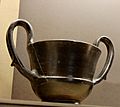Typology of Greek vase shapes facts for kids
The pottery of ancient Greece has a long history. The shapes of Greek vases changed and developed over many years, from the time of the Minoan civilization all the way to the Hellenistic period. Experts like Gisela Richter say that these vase shapes looked their best in the 5th and 6th centuries BC. Because the shapes changed over time, archaeologists can use them to figure out how old a vase is, especially for plain vases without pictures.
It's not easy to name all the different Greek vase shapes. When we say "vase" here, it means any kind of container. Archaeologists started trying to match vase shapes with names from old Greek writings a long time ago. For example, in 1829, Theodor Panofka wrote a book saying he had found the ancient names, but other experts quickly disagreed.
A few old vases actually had their names written on them. One hydria (a water jar) was shown on the famous François Vase with its name. Another kylix (a drinking cup) even says, "I am the decorated kylix of lovely Phito." Sometimes, paintings on vases show how people used them, which helps experts understand old descriptions. Most of what we know about Greek pots comes from writers like Athenaios and Pollux, who lived much later. They wrote about vases they hadn't seen, so their descriptions can be confusing. Even with these challenges, we generally agree on the names of Greek vases today. These names are more like agreed-upon labels than exact historical facts.
The vases mentioned here are mostly from Athens, around 500-400 BC. Their names follow a system created by John Beazley. Many vase shapes were first made from metal, especially silver, but not many of those metal vases survived. Some pottery vases were probably made as cheaper versions of these metal ones, either for daily use or to be placed as grave goods (items buried with the dead). Some names, especially for kylix (drinking cups), describe both the shape and how they were decorated, like the band cup or eye cup. Other names describe what the vase was used for, like the aryballos, which later potters made into many fun, unique shapes.
Main Types of Greek Vases
Greek pottery can be put into four main groups:
- Storage and Transport Vases: These were used to hold and move things. Examples include the amphora, pithos, pelike, hydria, stamnos, and pyxis.
- Mixing Vases: These were mainly used for symposia, which were parties where men drank together. Examples include the krater, dinos, and kyathos.
- Jugs and Cups: This group includes several types of kylix (drinking cups), the kantharos, phiale, skyphos, rhyton, mastos, and jug-types like the oinochoe and loutrophoros.
- Vases for Oils, Perfumes, and Cosmetics: These held special liquids. Examples are the larger lekythos, and the smaller aryballos, alabastron, and askos.
Some standard vase types were also made in very large sizes, sometimes even from stone, to be used as grave markers. Others were used as urns to hold ashes after someone died, or as items buried with the dead. Some taller vases could be shaped like figures (called "plastic" or "figure vases"), where the body of the vase looked like a sculpture, often a human head. This is a bit like a modern Toby jug.
Gallery of Vase Shapes
- Storage Vases
-
Amphora type A, around 520 BC.
-
Neck amphora, around 520 BC.
-
Belly amphora, with almost no separate neck.
-
Nikosthenic amphora, around 530 BC.
-
Stamnos, around 480–470 BC.
- Mixing Vases
-
Bell krater, around 330 BC.
- Cups
-
Kantharos type A.
-
Kylix type A.
-
Eye-cup, painted with eyes.
-
Merrythought cup, with unique "wishbone" handles.
-
Mastoid cup, like a mastos but with a flat base and often handles.
-
Rhyton, around 430 BCE.
-
Skyphos, around 740 BC.
-
Glaux skyphos.
- Small Oil and Perfume Vases
-
Alabastron, small holders for oil or perfume.
-
Pyriform Aryballos.
-
Fancy aryballos shaped like three cockle shells, 6th century BC.
-
Acorn lekythos.
-
Standard or cylinder lekythos around 490 BCE.
Parts of a Vase: Lips and Feet
- Lip Styles
- Foot Styles
See also
 In Spanish: Tipología de vasos griegos para niños
In Spanish: Tipología de vasos griegos para niños





































































